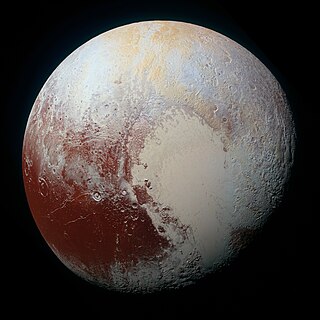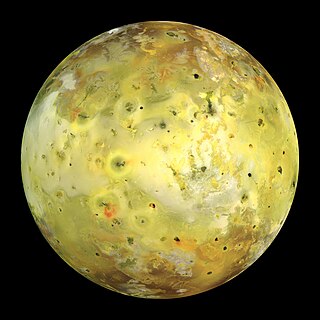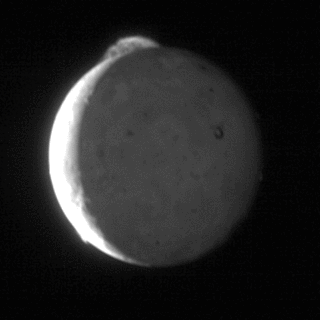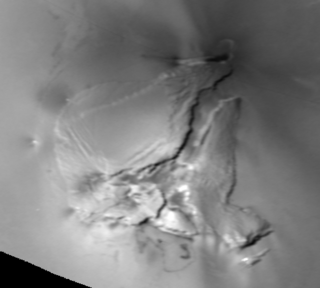External links
| Geology |
|  | ||||||||||||||
|---|---|---|---|---|---|---|---|---|---|---|---|---|---|---|---|---|
| Exploration |
| |||||||||||||||
| Other | ||||||||||||||||
This is a list of named geological features on Io , a moon of Jupiter. See also the list of mountains on Io and the list of paterae on Io.
Eruptive centers on Io, locations typically where major volcanic activity was observed and characterized before the volcanic landform was, are named after the gods of volcanoes and/or blacksmiths in various mythologies.
| Volcano | Named after |
|---|---|
| Amirani | Amirani (Georgian) |
| Kanehekili | Kanehekili (Hawaiian) |
| Loki | Loki (Norse) |
| Marduk | Marduk (Babylonian) |
| Masubi | Ho-Masubi (Japanese) |
| Maui | Māui (Hawaiian) |
| Pele | Pele (Hawaiian) |
| Prometheus | Prometheus (Greek) |
| Surt | Surtur (Icelandic) |
| Thor | Thor (Norse) |
| Volund | Volund (Norse) |
| Zamama | Zamama (Babylonian) |
On Io, catenae /kəˈtiːnə/ (crater chains, sg. catena) are named after sun gods in various mythologies. In 2006, the use of the term catena was discontinued in favor of the patera /ˈpætərə/ (plural paterae /ˈpætəriː/ ). Below is a list of features that previously used the descriptor term catena.
| Catena | Named after |
|---|---|
| Mazda Paterae | Ahura Mazda (Zoroastrian) |
| Reshet Patera | Reshet (Aramaic) |
| Tvashtar Paterae | Tvashtri (Hindu) |
Ionian fluctus /ˈflʌktəs/ (areas of lava flow) [1] are named after fire and thunder gods in various mythologies, or after locations in Greek mythology associated with Io.
Ionian mensae /ˈmɛnsiː/ (mesas, sg. mensa) are named after mythological figures associated with fire or with the nymph Io.
| Mensa | Named after |
|---|---|
| Capaneus Mensa | Capaneus ( The Divine Comedy ) |
| Echo Mensa | Echo (Greek) |
| Epaphus Mensa | Epaphus (Greek) |
| Hermes Mensa | Hermes (Greek) |
| Iynx Mensa | Iynx (Greek) |
| Pan Mensa | Pan (Greek) |
| Prometheus Mensa | Prometheus (Greek) |
| Telegonus Mensae | Telegonus, husband of Io (Greek) |
| Tvashtar Mensae | Tvashtar (Hindu) |
Ionian montes /ˈmɒntiːz/ (mountains and volcanos, sg. mons /ˈmɒnz/ ) are named after people and places associated with the nymph Io, and sun and fire gods in various other mythologies.
Ionian paterae /ˈpætəriː/ (shallow craters and crater chains) are named after sun gods and fire gods in various mythologies.
Ionian plana /ˈpleɪnə/ (plateaus, sg. planum /ˈpleɪnəm/ ) are named after locations in Greek mythology associated with the nymph Io.
| Planum | Named after |
|---|---|
| Argos Planum | Argos |
| Danube Planum | Danube River |
| Dodona Planum | Dodona |
| Ethiopia Planum | Ethiopia |
| Hybristes Planum | Hybristes |
| Iopolis Planum | Iopolis |
| Lyrcea Planum | Lyrcea |
| Nemea Planum | Nemea |
Ionian regiones /rɛdʒiˈoʊniːz/ (regions, sg. regio /ˈriːdʒioʊ/ ) are mostly named after locations in Greek mythology associated with the nymph Io.
Ionian tholi /ˈθoʊlaɪ/ (hills, sg. tholus /ˈθoʊləs/ ) are named after mythological figures associated with fire or with the nymph Io.
| Tholus | Named after | Coordinates |
|---|---|---|
| Apis Tholus | Apis (Greek) | 10°54′S347°53′W / 10.9°S 347.88°W |
| Inachus Tholus | Inachus (Greek) | 16°11′S347°46′W / 16.18°S 347.76°W |
| Tsui Goab Tholus | Tsui (Khoikhoi) | 0°06′S163°00′W / 0.1°S 163.0°W |

Planetary nomenclature, like terrestrial nomenclature, is a system of uniquely identifying features on the surface of a planet or natural satellite so that the features can be easily located, described, and discussed. Since the invention of the telescope, astronomers have given names to the surface features they have discerned, especially on the Moon and Mars. To found an authority on planetary nomenclature, the International Astronomical Union (IAU) was organized in 1919 to designate and standardize names for features on Solar System bodies.

A volcano is a rupture in the crust of a planetary-mass object, such as Earth, that allows hot lava, volcanic ash, and gases to escape from a magma chamber below the surface.

A dryad is a tree nymph or tree spirit in Greek mythology. Drys (δρῦς) signifies "oak" in Greek. Dryads were originally considered the nymphs of oak trees specifically, but the term has evolved towards tree nymphs in general. Often their life force was connected to the tree in which they resided and they were usually found in sacred groves of the gods. They were considered to be very shy creatures except around the goddess Artemis, who was known to be a friend to most nymphs.

Volcanology is the study of volcanoes, lava, magma and related geological, geophysical and geochemical phenomena (volcanism). The term volcanology is derived from the Latin word vulcan. Vulcan was the ancient Roman god of fire.

Io, or Jupiter I, is the innermost and second-smallest of the four Galilean moons of the planet Jupiter. Slightly larger than Earth's moon, Io is the fourth-largest moon in the Solar System, has the highest density of any moon, the strongest surface gravity of any moon, and the lowest amount of water by atomic ratio of any known astronomical object in the Solar System. It was discovered in 1610 by Galileo Galilei and was named after the mythological character Io, a priestess of Hera who became one of Zeus's lovers.

Tvashtar Paterae compose an active volcanic region of Jupiter's moon Io located near its north pole. It is a series of paterae, or volcanic craters. It is named after Tvashtar, the Hindu god of blacksmiths. Tvashtar was discovered in IRTF images in November 26 1999, several hours after a Galileo flyby. Images taken with the ESO 3.6m telescope and its adaptive optics in September 1999 revealed the presence of faint hot spot. The outburst was studied by the Galileo spacecraft over several years. During this time, a 25-kilometre (16 mi) long, 1-to-2-kilometre high curtain of lava was seen to erupt from one patera, a lake of superheated silicate lava erupted in the largest patera, and finally a plume of gas burst out, rising 385 kilometres (239 mi) above Io and blanketing areas as far away as 700 kilometres (430 mi).

Volcanism on Io, a moon of Jupiter, is represented by the presence of volcanoes, volcanic pits and lava flows on the surface. Io's volcanic activity was discovered in 1979 by Linda Morabito, an imaging scientist working on Voyager 1. Observations of Io by passing spacecraft and Earth-based astronomers have revealed more than 150 active volcanoes. As of 2004, up to 400 such volcanoes are predicted to exist based on these observations. Io's volcanism makes the satellite one of only four known currently volcanically or cryovolcanically active worlds in the Solar System

Monan Patera is a patera, or a complex crater with scalloped edges, on Jupiter's moon Io. It is about 137 kilometers in diameter and is located at 19.82°N 104.81°W. It is named after Monan, a god in Brazilian mythology that destroyed the world with fire and floods. Its name was adopted by the International Astronomical Union in 1997.

The Ceraunius Fossae are a set of fractures in the northern Tharsis region of Mars. They lie directly south of the large volcano Alba Mons and consist of numerous parallel faults and tension cracks that deform the ancient highland crust. In places, younger lava flows cover the fractured terrain, dividing it into several large patches or islands. They are found in the Tharsis quadrangle.

Masubi is an active volcano on Jupiter's moon Io. It is located on Io's leading hemisphere at 49.6°S 56.18°W within a bright terrain region named Tarsus Regio. A volcanic plume has been observed at Masubi by various spacecraft starting with Voyager 1 in 1979, though it has not been persistent like similar Ionian volcanoes Amirani and Prometheus. Masubi is also notable for having one of the largest active lava flows on Io, with an additional 240 km (150 mi) flow forming between 1999 and 2007.

Danube Planum is a rifted mesa on the surface of Jupiter's moon Io. It is located on Io's trailing hemisphere at 22.73°S 257.44°W. Danube Planum is 244.22 kilometers across and 5.5 km tall. The mountain is bisected by a 15-to-25-kilometer-wide, northeast–southwest-trending canyon, splitting the mountain into two main east and west mountains, with several additional blocks at the southern end of the fracture. The outer margin of the plateau is marked by 2.6-to-3.4-km-tall scarps. Mass wasting in the form of landslide deposits are visible along the base of the western half of Danube Planum. Two volcanic depressions, known as paterae, lie at northern and southern ends of mountain. The volcano at the northern end, Pele, is one of the most active volcanoes on Io. One of the faults that helped form Danube Planum may also act as a conduit for magma to rise to the surface at Pele.

Kanehekili Fluctus is a lava flow field on Jupiter's moon, Io. This fluctus is located in the sub-Jovian hemisphere at 17.68°S 33.56°W as shown in the picture on the right. Also in the picture is the Kanehekili volcanic center located at 18.21°S 33.6°W. This lava field covers roughly 34,500 square kilometres (13,300 sq mi). The hotspot was detected by the Galileo Solid State Imaging experiment (SSI) on orbits by Galileo.

The Chaac-Camaxtli region is a volcanic region on Jupiter's moon Io, located from approximately 5 to 20°N and 130 to 160°W in its anti-Jovian hemisphere. It consists mainly of the hummocky bright plains that occupy the surface. This area is defined on the west by Chaac Patera, and on the east by Camaxtli Patera. At least 10 distinct volcanic centers are located in the region, making it a volcanically active region on Io's surface. Most of the volcanism here is expressed as paterae, which range in size from circular to elliptical. A patera is defined by the International Astronomical Union as "irregular or complex craters with scalloped edges." The largest volcanic structure here is the Chaac Patera. The paterae found in the Chaac-Camaxtli region are Chaac, Balder Patera, Grannos, Ababinili, Ruaumoko, Steropes, Camaxtli, Tien Mu, Utu, and Mentu.

PateraPAT-ər-ə is an irregular crater, or a complex crater with scalloped edges on a celestial body. Paterae can have any origin, although the majority of them were created by volcanism. The term comes from Latin, where it refers to a shallow bowl used in antique cultures.